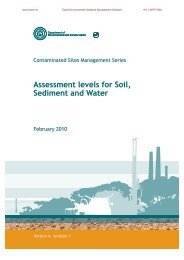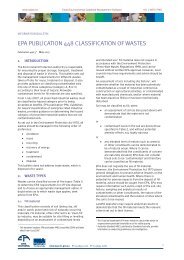Soil Generic Assessment Criteria for Human Health Risk ... - ESdat
Soil Generic Assessment Criteria for Human Health Risk ... - ESdat
Soil Generic Assessment Criteria for Human Health Risk ... - ESdat
Create successful ePaper yourself
Turn your PDF publications into a flip-book with our unique Google optimized e-Paper software.
www.esdat.net Esdat Environmental Database Management Software +61 2 8875 7948<br />
Bis ethylhexyl phthalate,<br />
di(2 ethylhexyl)phthalate or DEHP<br />
ID oral<br />
Organisation<br />
Committee on the Carcinogenicity of<br />
Chemicals in Food, Consumer Products and<br />
the Environment (COC)<br />
Study type Description Response Reference Web link<br />
CC/01/25<br />
http://www.iacoc.org.uk/papers/documents/mindurcarcstudy.PDF<br />
COMMITTEE ON CARCINOGENICITY OF CHEMICALS IN FOOD<br />
CONSUMER PRODUCTS AND THE ENVIRONMENT<br />
THE MINIMUM DURATION OF CARCINOGENICITY STUDIES IN RATS, November<br />
2001<br />
European Chemicals Bureau (ECB)<br />
Based on the overall evaluation of the studies on<br />
mutagenicity (see Section 4.1.2.8) DEHP and<br />
its major metabolites can be regarded as non-genotoxic<br />
agents.<br />
European Union <strong>Risk</strong> <strong>Assessment</strong> Report Volume 80 , 2008<br />
http://ecb.jrc.ec.europa.eu/DOCUMENTS/Existing-<br />
Chemicals/RISK_ASSESSMENT/REPORT/dehpreport042.pdf<br />
International Agency <strong>for</strong> Research on Cancer<br />
(IARC)<br />
Di(2-ethylhexyl) phthalate is not classifiable as to its<br />
carcinogenicity to humans (Group 3) .<br />
International Agency <strong>for</strong> Research on Cancer (IARC) - Summaries &<br />
Evaluations<br />
DI(2-ETHYLHEXYL) PHTHALATE<br />
(Group 3)<br />
VOL.: 77 (2000) (p. 41)<br />
http://www.inchem.org/documents/iarc/vol77/77-01.html<br />
ICPS Environmental <strong>Health</strong> <strong>Criteria</strong> (EHC)<br />
Monographs<br />
No data in EHC131…" Currently there is not sufficient<br />
evidence to suggest that DEHP is a potential human<br />
carcinogen."<br />
http://www.inchem.org/documents/ehc/ehc/ehc131.htm<br />
WHO Guidelines <strong>for</strong> drinking water Quality<br />
Hinton RH et al. Effects of phthalic acid esters on the liver<br />
and thyroid.<br />
Di(2-ethylhexyl)phthalate in Drinking-water Background document <strong>for</strong><br />
development of WHO Guidelines <strong>for</strong> Drinking-water Quality WHO 2003, &<br />
Guidelines <strong>for</strong> Drinking-water Quality FIRST ADDENDUM TO THIRD EDITION<br />
Volume 1 Recommendations WHO 2006<br />
http://www.who.int/water_sanitation_health/dwq/gdwq0506.pdf &<br />
http://www.who.int/water_sanitation_health/dwq/chemicals/di2ethylhexyp<br />
hthalate.pdf<br />
Dutch National Institute <strong>for</strong> Public <strong>Health</strong> and<br />
the Environment (RIVM) Maximum<br />
Permissible <strong>Risk</strong> (MPR) levels<br />
Baars et al states that there is no indication that DEHP is a<br />
genotoxic carcinogen.<br />
re-evaluation of maximum permissible levels By Baars et al RIVM 711701025/2001http://www.rivm.nl/bibliotheek/rapporten/711701025.pdf (Baars et al)<br />
<strong>Health</strong> Canada Toxicological Values<br />
"The weight of evidence also indicates that the metabolites<br />
of bis(2-ethylhexyl) phthalate, mono(2-ethylhexyl) phthalate,<br />
and 2-ethylhexanol, are not genotoxic."<br />
Bis(2-ethylhexyl) Phthalate - PLS1<br />
http://www.hc-sc.gc.ca/ewh-semt/pubs/contaminants/psl1-<br />
lsp1/bis_2_ethylhexyl/bis_2_ethylhexyl_3-eng.php<br />
US Agency <strong>for</strong> Toxic Substances and Disease<br />
Registry (ATDSR) Toxicological Profiles and<br />
Minimal <strong>Risk</strong> levels<br />
No studies located regarding genotoxic effects in humans .<br />
DEHP has been extensively tested in short-term genotoxicity<br />
assays with predominantly negative or false-positive results.<br />
Weight of evidence indicates that DEHP best characterized as<br />
an epigenetic toxicant.<br />
Toxicological Profile <strong>for</strong> Di(2-ethylhexyl)phthalate (DEHP) September 2002 including<br />
Reference: David RM, Moore MR, Finney DC, et al. 2000a. Chronic toxicity of<br />
di(2-ethylhexyl)phthalate in rats. Toxicol Sci 55:433-443.<br />
http://www.atsdr.cdc.gov/toxprofiles/tp9.pdf (&<br />
http://www.atsdr.cdc.gov/mrls/index.html <strong>for</strong> MRLs)<br />
USEPA Integrated <strong>Risk</strong> In<strong>for</strong>mation System<br />
(IRIS)<br />
Mouse/B6C3Fl,<br />
male. Dietary.<br />
Classification — B2; probable human carcinogen. Basis —<br />
Orally administered DEHP produced significant dose-related<br />
increases in liver tumor responses in rats and mice of both<br />
sexes. Based on risk of 1in 1e5.<br />
Tumor Type: hepatocellular carcinoma and adenoma NTP, 1982 Classification http://www.epa.gov/ncea/iris/subst/0014.htm<br />
Page 8 of 10<br />
EIC_pro<strong>for</strong>ma_bis_ethylhexyl_phthalate.xls26/08/2009








